Since the introduction of live cars (socks) and mechanized seines in the 1960s, innovations in catfish harvesting have been largely the result of trial-and-error by commercial net builders, fish producers and custom seining crews. Although there were minor modifications in the design of seines and live cars based on research in the 1970s, research played little part in the early development of harvest technology.
The Southern Regional Aquaculture Center (SRAC) funded a 3-year study in 1990 to develop new and improved harvest technologies. From that study, several new technologies appeared to have the potential to improve seining efficiency, including modified seines with rubber-roller mud lines. Little of this technology was implemented by the catfish industry, and inefficient harvesting and improper fish sizing continued to be major problems. As a result, catfish culturists requested that further research be conducted. The Harvest/Gear Technology program began in 1996 at the Thad Cochran National Warmwater Aquaculture Center (NWAC) in Stoneville, Mississippi, in collaboration with the National Marine Fisheries Service’s (NMFS) Harvesting Systems Division in Pascagoula, Mississippi. The goal of the program was to develop new harvest/grading technologies for the catfish industry. The program was supported, in part, by a 3-year SRAC project entitled “Development of Improved Harvesting, Grading and Transport Technology for Finfish Aquaculture.” This report presents the specifications for a more efficient seine/live car based on this research. Although developed for catfish culture, this technology should apply to other fish grown in ponds and harvested by seining.
A limited discussion of typical catfish harvest techniques is included to highlight the benefits of the experimental seine. For a more indepth description of fish harvesting techniques, see SRAC Publication No. 394, “Harvesting Warmwater Fish,” or “Catfish Harvesting” (http://msucares.com/aquaculture/catfish/harvest.html).
General harvesting methods
Catfish seines are usually 6, 9 or, more rarely, 12 feet deep. They range from 1,000 to 1,400 feet long to reach across the longest parts of ponds. Currently, most food-size catfish are harvested with a 1 5⁄8-inch mesh seine, which allows fish under a pound to grade through the seine as it is pulled through the pond. This greatly reduces the stress of crowding on the fish. Seines typically have 1⁄2-inch poly-plus ropes on the top and bottom with 3-inch x 3-inch floats every three ties on the top line and a 2-ounce lead every two ties on the bottom line. Another bundled nylon netting mud line is tied to the lead line to help hold the seine on the bottom as it is pulled. Some seiners pay more for larger floats (4-inch x 3- inch or 3 3⁄8-inch x 5 3⁄8-inch bullet shaped) with grommets, which reduces losses caused by the pressure of the reel on the floats as the seine is reeled in. The larger floats help reduce the tendency of the seine to sink below the pond surface when mud accumulates along its bottom. A funnel area is built into each seine about 150 feet from one or both ends as an attachment point for a live car.
A seine is loaded onto a large, tractor-driven, hydraulic reel (Fig. 1), which allows it to be reeled in or out easily as needed during seining. Ponds are usually seined from the deep end to the shallow end to keep fish from escaping under the seine bottom once the fish are concentrated in the harvest area. However, ponds can be seined toward the deep end if the seine has sufficient depth to work properly.
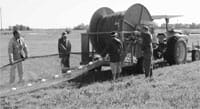 Figure 1. Seine being loaded on a seine reel. Figure 1. Seine being loaded on a seine reel. |
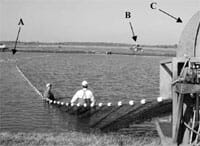 Figure 2. A = Seine funnel (closed); B = Pull tractor; C = Seine reel (tractor not pictured). Figure 2. A = Seine funnel (closed); B = Pull tractor; C = Seine reel (tractor not pictured). |
 Figure 3. A = Seine funnel; B = Live car (in bottom of boat); C = Seine push rack. Figure 3. A = Seine funnel; B = Live car (in bottom of boat); C = Seine push rack. |
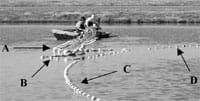 Figure 4. A = Live car; B = Seine funnel; C = Pull side of seine; D = Reel side of seine. Figure 4. A = Live car; B = Seine funnel; C = Pull side of seine; D = Reel side of seine. |
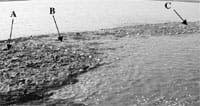 Figure 5. A = Harvest area; B = Funnel area (top covered); C = Front end of live car; note that all areas shown are densely packed with fish. Figure 5. A = Harvest area; B = Funnel area (top covered); C = Front end of live car; note that all areas shown are densely packed with fish. |
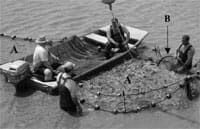 Figure 6. A = Live car split for loading; B = Loading basket being inserted in the edge of the live car. Figure 6. A = Live car split for loading; B = Loading basket being inserted in the edge of the live car. |
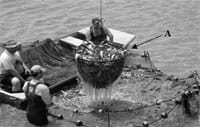 Figure 7. A = Full loading basket being picked up out of the live car. Figure 7. A = Full loading basket being picked up out of the live car. |
At this point, seining stops and one or two workers attach a live car to the seine by joining the zippers in the end of the live car and seine funnel (Fig. 4). Then the two sides of the seine and the attached live car are pulled slowly and evenly to the bank, forcing the fish through the seine funnel and into the live car. Generally, several workers will spread out around the sides of the seine to make sure the seine top does not go under water, which could allow fish to escape. Figure 5 illustrates how the sides of the seine, funnel area and live car of the experimental seine line up, giving the fish an unrestricted path.
Seining and loading procedures have become relatively standardized in the catfish industry. To begin seining, the seine-reel tractor is positioned near one corner of the pond deep end (with the mud line side of the reel nearest the pond). The free end of the seine is attached to a second tractor that pulls the seine off the reel and across the starting levee. Once the second tractor is on the other side, both tractors pull the seine through the pond toward the shallow end (Fig. 2). The tractors can be moved forward simultaneously or alternately, depending on how badly the seine bogs down in the mud. A seining boat equipped with a 25- to 35-horsepower outboard motor and a front-mounted push-rack (Fig. 3) catches the seine top and pushes it forward to dump mud from the seine. Once the accumulated mud is dumped, the tractor drivers are signaled to move forward again. Having to continually clear mud from the seine can increase seining time by several hours, especially in old, shallow, muddy ponds. A harvest area about 70 x 150 feet in size is established once the pull tractor gets around the last pond corner and reaches a point near the seine reel tractor. Depending on the number of fish in the pond, the pond size, and the number of fish grading through the seine, there could be 50,000 to 100,000 catfish of various sizes trapped in this small area.
In hot weather, or if the water is shallow and muddy from fish or worker activity, the detached live car can be pulled into clear, deeper water and staked out. At this point, most farmers place a slowturning, tractor-driven paddle wheel or pump near the live car for aeration; the fish can now be safely held until it is time for them to be loaded onto the livehaul truck for transport to the processor.
Sometimes workers will split a sock for loading when the weather is hot or when the live car is heavily loaded with fish (Fig. 6). When possible, fish are allowed to grade until the majority of fish are the size needed by the processing plant. Moving small fish to the plant is costly to both the producer and processor. The loading process involves crowding the fish to one end of the sock so that a full basket of fish can be captured with each dip (Fig. 7) and swung up above an open tank door on the live haul truck and dumped (Fig. 8). (Photographs in Figures 6-8 were taken during a pond harvest using a conventional seine.)
Live cars are usually 8 to 10 feet wide by 50 to 100 feet long with large floats spaced around the outside top line. Additional floats are placed along the inside edge of a skirt designed to minimize the number of fish escaping over the top of the live car. Live cars come in a variety of mesh sizes so a farmer can choose a mesh size that will hold the size fish needed by the processing plant and at the same time release the smaller fish back into the pond. About 50,000 to 100,000 pounds of catfish can be held in one live car at a fish biomass as high as 20 pounds per cubic foot. The fish may be loaded immediately onto the live-haul truck, allowed to grade for a few hours, or held overnight if the processor needs them early the next morning.
Further Information
To continue reading this article, please click hereMay 2007

